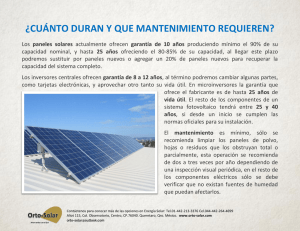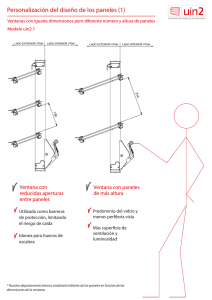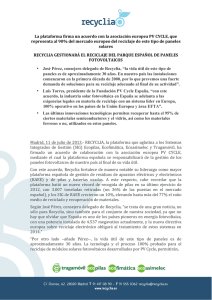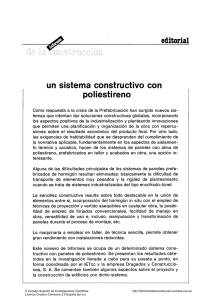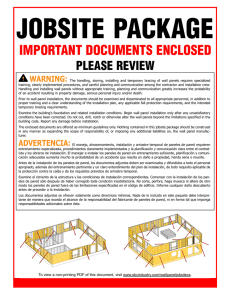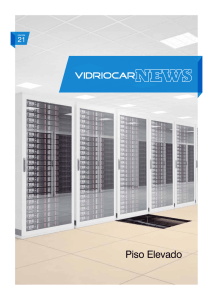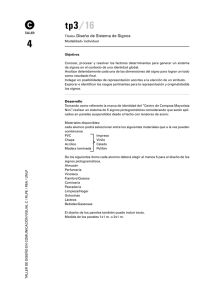Sistemas modulares prefabricados
Anuncio
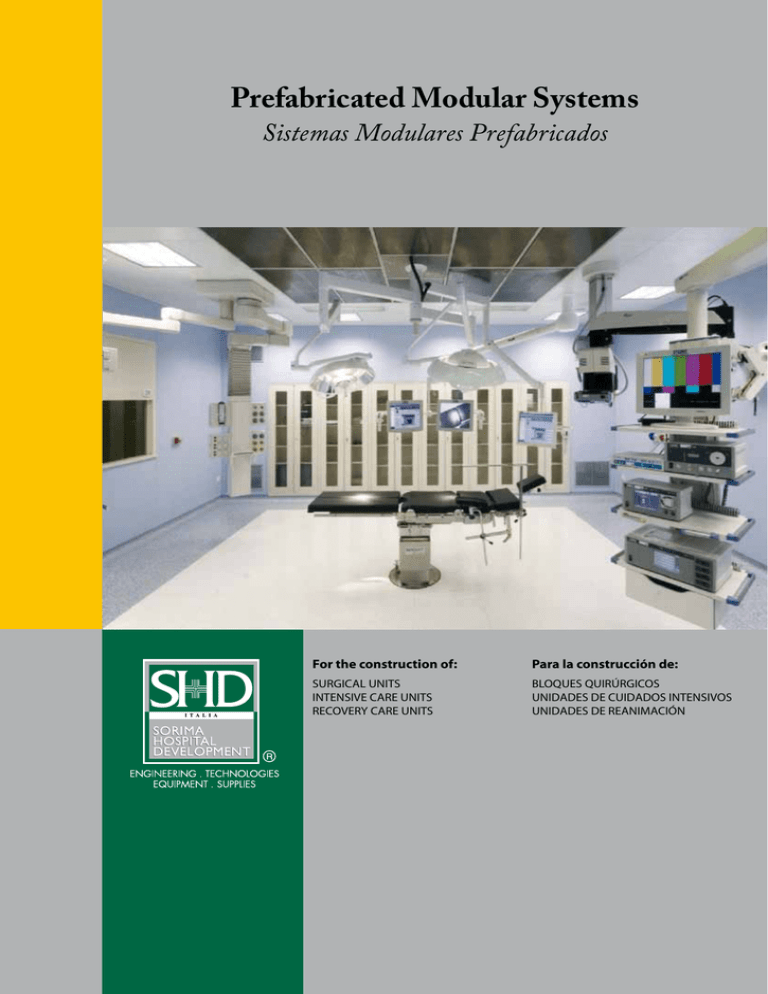
Prefabricated Modular Systems Sistemas Modulares Prefabricados For the construction of: Para la construcción de: SURGICAL UNITS INTENSIVE CARE UNITS RECOVERY CARE UNITS BLOQUES QUIRÚRGICOS UNIDADES DE CUIDADOS INTENSIVOS UNIDADES DE REANIMACIÓN SHD Italia SHD Italia has been designing, manufacturing and installing surgical units, intensive care units and recovery care units for more than 30 years in various parts of the world, constantly refining design projects and products on the basis of accumulated experience. SHD Italia ha estado diseñando, fabricando e instalando quirófanos, unidades de cuidados intensivos y de recuperación durante más de 30 años, en Italia y en el extranjero, perfeccionando constantemente Proyectos de diseño y productos basándose en la experiencia acumulada. SHD Italia manufactures specific modular cladding and prefabricated self-loading partition systems that guarantee optimal and flexible utilisation of spaces in critical hospital departments requiring controlled bacterial contamination conditions. SHD Italia fabrica revestimientos modulares específicos y sistemas de división autoportantes que garantizan una utilización óptima y flexible del espacio en departamentos hospitalarios críticos que requieren condiciones de contaminación bacteriana controlada. SHD Italia offers its expertise and experience, collaborating with top professionals in the healthcare sector, studying and developing solutions aimed at meeting the needs of customers and ensuring the maximum efficiency for the work of the medical team. SHD Italia ofrece sus conocimientos y experiencia colaborando con los principales profesionales del sector de la sanidad, estudiando y desarrollando soluciones destinadas a satisfacer las necesidades de los clientes y garantizando la máxima eficiencia para el trabajo del equipo médico. Surgical Units Operating Theatres Adjoining Service Rooms Bloques quirúrgicos Quirófanos Salas de servicios contiguas Intensive Care Units Recovery Care Units 7 Prefabricated Modular Systems 8 Unidades de cuidados intensivos Unidades de reanimación Sistemas modulares prefabricados Lindo® System 12 Lindo® Doors 16 3D Design 18 Sistema Lindo® Puertas Lindo ® Diseño en 3D 2 4 3 Surgical Units Bloques Quirúrgicos OPERATING THEATRES From the technological standpoint the surgical unit is the core of a modern healthcare facility. The technological devices currently utilised are of a level of sophistication that permits integrated management of all the equipment and data needed by the surgical team during their work. The heavy workload to which theatre personnel are frequently subjected calls for a suite of comfortable and modern rooms, designed in such a way as to allow surgeons and the entire team to work with the maximum effectiveness and to ensure the highest possible level of protection for patients. The instruments, utility networks, and furniture must be such as to create an environment that, although complex, is also uniform and integrated, where each function can be controlled and guaranteed and where operating and maintenance tasks can be expedited easily and effectively. To date, SHD Italia has produced and installed more than 1000 Prefabricated Surgical Units in Italy and internationally, several of which have been in service for almost 30 years although they still retain their original aesthetic and functional qualities. QUIRÓFANOS Desde el punto de vista tecnológico, el bloque quirúrgico es el corazón de una moderna instalación de atención sanitaria. Los dispositivos tecnológicos actualmente utilizados tienen un nivel de sofisticación que permite la gestión integrada de todos los equipos y datos necesarios por el equipo quirúrgico durante su trabajo. La densa carga de trabajo a la que está frecuentemente sometido el personal de quirófano exige un conjunto de salas cómodas y modernas diseñadas de tal forma que permitan a los cirujanos y a todo el equipo trabajar con la máxima efectividad y garantizar el mayor nivel de protección posible para los pacientes. Los instrumentos, las redes de servicios y el mobiliario deben ser tales que creen un entorno que, aunque complejo, sea también uniforme e integrado, donde cada función pueda ser controlada y garantizada y donde las tareas operativas y de mantenimiento puedan ser agilizadas de forma fácil y efectiva. Al día de hoy, SHD Italia ha fabricado e instalado más de 1000 bloques quirúrgicos prefabricados en Italia e internacionalmente, varios de los cuales han estado en servicio durante casi 30 años, manteniendo aún hoy sus calidades estéticas y funcionales. we listen to your needs Escuchamos sus necesidades 4 5 ADJOINING SERVICE ROOMS Today’s most popular solution for other rooms in the Surgical Suite, Recovery Rooms and Intensive Therapy Units, consists of panels faced in HPL Laminate, an easily cleaned, impact and abrasion resistant material that offers big cost savings. SALAS DE SERVICIOS CONTIGUAS La solución actual más popular para otras salas del bloque quirúrgico, salas de reanimación y unidades de cuidados intensivos, consiste en paneles forrados de laminado HPL, un material de fácil limpieza, resistente al impacto y a la abrasión, que ofrece grandes ahorros de coste. Intensive Care Units and Recovery Care Units Unidades de Cuidados Intensivos y Unidades de Reanimación 6 7 Prefabricated Modular Systems Sistemas Modulares Prefabricados WHY USE A PREFABRICATED SYSTEM? 1. • • • CONFIDENCE costs clearly stated well in advance; remarkably short realisation times; guaranteed hygiene. 2. VERSATILITY - Throughout the execution of the works: • low noise, clean, and dry installation procedures mean that the department can continue to operate while work is in progress and ensure minimum interference with adjoining departments; • different specialist contractor companies can work simultaneously on the same project; • modifications can be made easily on the job to accommodate revised technical requirements. 3. FLEXIBILITY - Once the new structure is operational: • maintenance performed rapidly without generating department downtimes; • easy plant modifications to accommodate new requirements and/or revised legislative prescriptions; • easy modifications to incorporate the latest integrated equipment control systems; • easy modifications to adapt the system to provide protection against ionising radiation propagation; • changes can be made easily to the operational layout to meet emerging requirements of the hospital structure. 4. INNOVATION, ENVIRONMENTAL COMFORT AND VISUAL IMPACT • Modern prefabricated systems are highly engineered and industrialised and, thanks to the use of aesthetically high quality materials, they make it possible to obtain an optimal visual impact and enhanced environmental comfort for the medical team. 8 POR QUÉ UTILIZAR UN SISTEMA PREFABRICADO? 1. CONFIANZA • Costes claramente establecidos con mucha antelación; • Tiempos de ejecución notablemente cortos; • Higiene garantizada. 2. VERSATILIDAD - A lo largo de toda la duración de la obra: • Procedimientos de instalación con poco ruido, limpios y secos, significa que el departamento puede seguir operando mientras la obra está en marcha y garantizar una interferencia mínima con los departamentos colindantes; • Diferentes contratistas especializados pueden trabajar simultáneamente en el mismo proyecto; • Se pueden realizar fácilmente modificaciones durante la tarea para adaptar requisitos técnicos modificados. 3. FLEXIBILIDAD - Una vez está operativa la nueva estructura: • Mantenimiento realizado rápidamente sin provocar paros en el departamento; • Modificaciones sencillas de la planta para adaptar nuevas exigencias y/o prescripciones legales revisadas; • Modificaciones sencillas para incorporar los sistemas de control de equipos integrados más recientes; • Modificaciones sencillas para adaptar el sistema para que proporcione protección contra la propagación de radiaciones ionizantes; • Se pueden hacer fácilmente cambios a la disposición operativa para satisfacer requisitos emergentes en la estructura del hospital. 4. INNOVACIÓN, CONFORT AMBIENTAL E IMPACTO VISUAL • Los sistemas prefabricados tienen una alta tecnología e industrialización y, gracias a la utilización de materiales de elevada calidad estética permiten obtener un impacto visual óptimo y mejorar el confort ambiental del equipo médico . 9 10 TYPICAL TECHNICAL FEATURES OF MODERN PREFABRICATED MODULAR SYSTEMS: • Absolute flatness The qualifying technical features of a properly executed system consist of its rounded shapes and the total absence of live edges, ensuring that all surfaces are perfectly flush without protrusions, specifically: - vertical sealing joints between facing panels; - door frame linings and finishing panels; - suspended ceiling and finishing panels; - floor surface and finishing panels. • Full height finishing panels Avoiding the need for horizontal joints between panels and so minimising critical points of bacterial accumulation and proliferation. • Maximum width modular finishing panels Fewer vertical joints between panels thereby reducing critical points of bacterial accumulation and proliferation. • Vertical level adjustment of subframe Excellent ability to compensate for significant level differences, imperfections and irregularities in the screed/floor of up to at least ± 20 mm. • Hermetic sealing and sound insulation The use of twin level sealing gaskets interposed between the rear edge of the panels and the subframe, combined with several other technical solutions, ensures a hermetic seal thus preventing the ingress of contaminated air from system voids while imparting an excellent level of sound insulation. The hermetic nature of the structure also actively contributes to the efficiency of the air treatment plant. • Non-flammable materials All components must be rated as fire reaction class 0 or 1. • Viewing windows It must be possible to integrate hermetically sealed partially or totally glazed viewing modules. • Sealed and hermetically sealed doors It shall be possible to install sealed or hermetically sealed doors also in conventional masonry walls in the department for use in refurbishment projects. • Finishing panels Wide range of matt, anti-glare finishing materials with different performance features and costs to ensure that the appropriate version of the same system can be used throughout the entire department. The most high-tech areas of the suite are generally created using the finishing materials that offer the highest technological performance while adjacent rooms can be created using less sophisticated materials that retain the same aesthetic appearance and compatible performance levels. • Ease of disassembly The suspended ceiling panels and the vertical finishing panels shall be rapidly and individually demountable. CARACTERÍSTICAS TÉCNICAS TÍPICAS DE LOS MODERNOS SISTEMAS MODULARES PREFABRICADOS: • Planitud absoluta Las características técnicas que califican un sistema correctamente realizado consisten en sus formas redondeadas y la ausencia total de aristas, lo que garantiza que todas las superficies están perfectamente enrasadas, sin salientes, específicamente: - juntas de unión vertical entre paneles de revestimiento; - revestimientos de marcos de puerta y paneles de acabado; - techos suspendidos y paneles de acabado; - superficie de suelo y paneles de acabado. • Paneles de acabado de altura completa Que evitan la necesidad de juntas horizontales entre paneles y así se minimizan puntos críticos de acumulación y proliferación bacteriana. • Paneles de acabado modulares de la máxima anchura Menos juntas verticales entre paneles reduciendo así puntos críticos de acumulación y proliferación bacteriana. • Ajuste del nivel vertical del bastidor Excelente capacidad para compensar diferencias de nivel significativas, imperfecciones e irregularidades del suelo de hasta al menos ± 20 mm. • Cierre hermético y aislamiento acústico El uso de juntas con dos niveles interpuestas entre el borde posterior de los paneles y el bastidor, combinado con otras diversas soluciones técnicas, garantiza un cierre hermético que impide la entrada de aire contaminado desde los huecos del sistema a la vez que imparte un excelente nivel de aislamiento acústico. La naturaleza hermética de la estructura, también contribuye activamente a la eficiencia de la planta de tratamiento de aire. • Materiales no inflamables Todos los componentes deben tener una reacción al fuego clase 0 o 1. • Mirillas Debe ser posible integrar módulos de visión herméticamente sellados, parcial o totalmente acristalados. • Puertas cerradas y herméticamente cerradas También será posible instalar puertas estancas o herméticamente cerradas en paredes de mampostería convencional en el departamento para usar en proyectos de remodelación. • Paneles de acabado Amplio surtido de materiales de acabado mate, antideslumbrante, con diferentes características y costes para garantizar que se pueda usar la versión correcta del mismo sistema en todo el departamento. Las zonas de más alta tecnología del bloque se crean, generalmente, utilizando los materiales de acabado que ofrecen las mayores prestaciones tecnológicas, mientras que se pueden realizar salas colindantes utilizando materiales menos sofisticados pero que conserven el mismo aspecto estético y niveles de prestaciones compatibles. • Facilidad de desmontaje Los paneles de techo suspendidos y los paneles de acabado verticales serán rápida e individualmente desmontables. 11 Lindo System ® Sistema Lindo® CHARACTERISTICS The Lindo® prefabricated self-loading modular System, available in wall cladding or partition version, offers technological innovaton and extreme flexibility, with its basic composition of a steel subframe to which finishing panels, doors and integrated accessories are mounted. CARACTERÍSTICAS El sistema modular prefabricado autoportante Lindo®, disponible en versión revestimiento mural o tabique, ofrece innovación tecnológica y extrema flexibilidad con su composición básica de un bastidor de acero en el que se montan paneles de acabado, puertas y accesorios integrados. The design of the Lindo® System ensures that the same basic self-loading subframe can be clad with all types of finishing panels. El diseño del Sistema Lindo® garantiza que el mismo bastidor autoportante básico se puede revestir con todos los tipos de paneles de acabado. RANGE OF SURFACE FINISHINGS: •Asepsi Antibacterial SMS® (Solid Mineral Surface®); •Toughened Glass; •Stainless Steel; •Painted Stainless Steel; • Painted Steel; •Stratified HPL Laminate; •HPL Laminate. GAMA DE ACABADOS SUPERFICIALES: •Asepsi Antibacterial SMS® (Solid Mineral Surface®); •Vidrio templado; •Acero inoxidable; •Acero inoxidable pintado; •Acero pintado; •Laminado HPL estratificado; •Laminado HPL. VERTICAL JOINTS: 1. Joint-cover gasket in nontoxic silicone rubber. This solution imparts a hermetic seal and allows linear expansion, while also ensuring fast and easy demounting of individual panels – even once the department is operational. 2. Made of nontoxic monolithic structural silicone in compliance with standards concerning clean rooms, and resistant to micro organism attack. This solution ensures hermetic sealing and absolute flatness of the surfaces, while also allowing fast and easy demounting of individual panels even once the department is operational. 3. Welding. Welding can be performed exclusively on Asepsi Antibacterial SMS® (Solid Mineral Surface®) panels and, although it provides absolute flatness of the wall surface it eliminates the facility for subsequent demounting of individual panels. 1 2 JUNTAS VERTICALES: 1. Junta tapajuntas de goma de silicona no tóxica. Esta solución ofrece un cierre hermético y permite la dilatación lineal a la vez que garantiza un desmontaje rápido y sencillo de los paneles individuales - incluso una vez operativo el departamento. 3 2.De silicona estructural monolítica no tóxica, que cumple las normas concernientes a salas limpias, y es resistente al ataque de los microorganismos. Esta solución garantiza una junta hermética y una planitud total de las superficies, a la vez que permite un desmontaje rápido y sencillo de los paneles individuales incluso una vez operativo el departamento. 12 3.Soldadura. La soldadura se puede realizar exclusivamente en los paneles de Asepsi Antibacterial SMS® (Solid Mineral Surface ®) y, aunque proporciona una planitud absoluta de la superficie de la pared, elimina la posibilidad del desmontaje posterior de paneles individuales. 13 HYGIENE The Lindo® System offers total ease of cleaning and sanitisation thanks to the absence of live corners and the fact that the surfaces are perfectly flush with no protrusions. Lindo® System, with its certified pressure tightness, also contributes actively to the performance of the air treatment system by ensuring that there is no ingress into clean air rooms of potentially contaminated air in system voids. ACOUSTIC INSULATION Assure certified acoustic insulation of at least 52 dB. FIRE RESISTANCE The materials utilised all offer excellent fire reaction characteristics. X-RAY PROTECTION Whenever necessary, Lindo® System can be equipped with X-ray shielding composed of 99.9% purity lead sheets housed in the system’s wall cavities. LOOKS The use of aesthetically appealing material translates into higher levels of environmental comfort for Surgical Unit staff. Thanks to the maximum freedom of choice in colours, even when the finishing panels in the Operating Theatre are made of different material with respect to those in adjoining areas of the suite, colours can be perfectly matched or coordinated, with impressive results in terms of overall visual impact. HIGIENE El Sistema Lindo® ofrece una facilidad total de limpieza y desinfección gracias a la ausencia de esquinas vivas y al hecho de que las superficies están perfectamente a nivel, sin salientes. El Sistema Lindo®, con su estanqueidad a la presión certificada también contribuye activamente al rendimiento del sistema de tratamiento de aire, garantizando que no hay entrada de aire potencialmente contaminado de los huecos del sistema a las salas de aire limpio. AISLAMIENTO ACÚSTICO Garantiza un aislamiento acústico certificado de al menos 52 dB. RESISTENCIA AL FUEGO Los materiales utilizados ofrecen todos ellos excelentes características de reacción al fuego. PROTECCIÓN CONTRA RAYOS X Siempre que sea necesario, el Sistema Lindo® puede estar provisto de protección contra los rayos X, compuesta por láminas de plomo del 99,9% de pureza, alojadas en los huecos de las paredes del sistema. 14 ASPECTO El uso de materiales estéticamente atractivos se traduce en altos niveles de confort ambiental para el personal del bloque quirúrgico. Gracias a la máxima libertad de elección de colores, incluso cuando los paneles de acabado del quirófano están fabricados con diferentes materiales con respecto a los de las áreas colindantes del bloque, los colores pueden coincidir o coordinarse perfectamente, con impresionantes resultados en términos de impacto visual global. 15 Lindo Doors ® Puertas Lindo® The Lindo® System allows the integrated and perfectly coplanar incorporation of sealed or hermetically sealed doors. Doors can be hinged or sliding with one or two leaves, with automatic or manual opening. The same door types can also be installed in conventional walls to create coordinated aesthetics (and functionality) throughout the entire department. El Sistema Lindo® permite la incorporación integrada y perfectamente plana de puertas cerradas o herméticamente cerradas. Las puertas pueden ser batientes o correderas, de una o dos hojas, con apertura automática o manual. También se pueden instalar los mismos tipos de puertas en paredes convencionales para crear estética (y funcionalidad) coordinada en todo el departamento. we provide a turnkey service Proporcionamos un servicio llave en mano FINISHING DOOR PANELS •Asepsi Antibacterial SMS® (Solid Mineral Surface®); •Toughened Glass; •Stainless Steel; •Painted Stainless Steel; • Asepsi Ceramicsteel® porcelain steel; •Stratified HPL Laminate; •HPL Laminate. PANELES DE ACABADO DE PUERTA • Asepsi Antibacterial SMS® (Solid Mineral Surface®); • Vidrio templado; • Acero inoxidable; • Acero inoxidable pintado; • Acero porcelánico Asepsi Ceramicsteel®; • Laminado HPL estratificado; • Laminado HPL. 16 17 3D Design Diseño en 3D Normally, conventional CAD Design systems are still able to satisfy requirements for the design of relatively simple hospital environments. However, the very high level of technology incorporated in a modern Surgical Unit calls for thorough planning of every minimum detail of the available space. Firstly, the potential level of satisfaction of the requirements to be addressed must be analysed in advance. Once the technological, functional, dimensional and economic requirements have been identified, the designer can create an environmental layout view with tools that make it possible to reproduce the entire area of the project in 3D. At this point all critical aspects must be identified with the utmost precision, both in the visible and occupied areas (work spaces) and in concealed areas of the system, i.e. all the voids and cavities in which technical systems are to be accommodated. This is particularly helpful since a surgical unit normally contains a high density of technical systems and it is not uncommon to encounter difficulties in finding space for the location and distribution of technical systems without being obliged to infringe on room spaces and volumes. This problem is especially common in renovation work, where designers frequently encounter insufficiently high ceiling voids or mandatory routes or positions for the accommodation of supply equipment. It follows that the very high technological level of the equipment installed in an operating theatre calls for a careful analysis of the siting and routing of the technical systems to which the various appliances are connected. 18 Right from the start the 3D project provides a faithful reproduction of the final configuration of the Surgical Unit – an invaluable tool helping to keep track of design aspects throughout the entire duration of the project. Each phase of management and installation on the worksite can be easily monitored because the entire process of preparation, supply, and delivery of materials to the site is guided and coordinated directly by the highly precise and sequential output data that the planning software retrieves directly from the virtual layout. This makes it possible to achieve a drastic reduction in the times required for procurement and shipping of materials to the worksite, ensuring that availability is perfectly coordinated with requirements in the various stages of erection. This means that the designer can immediately get an overview of the finished project, also giving the customer the same level of access simply by forwarding the relative files. The 3D project allows the end user to check the functionality of the spaces, instrumentation and furniture in a totally intuitive manner – even for people with little or no experience in interpreting 2D layout drawings. Navigating through the Surgical Unit using virtual reality tools allows the user to interact with the environment and achieve total familiarity with the final result. For particularly complex environments or critical situations, it’s also possible to simulate movements, postures, and ease of access to objects or equipment. A reliable preview of what will become the real situation of instruments and accessories in the area makes it possible to optimise ergonomic aspects of the Surgical Unit. Normalmente, los sistemas de diseño CAD aún pueden cumplir con los requisitos del diseño de entornos hospitalarios relativamente sencillos. Sin embargo, el muy elevado nivel tecnológico incorporado en un bloque quirúrgico moderno exige una perfecta planificación de cada mínimo detalle del espacio disponible. En primer lugar, se debe analizar con antelación el posible nivel de satisfacción de los requisitos a abordar. Una vez identificados los requisitos tecnológicos, funcionales, dimensionales y económicos, el diseñador puede elaborar una vista de la disposición ambiental con herramientas que permitan reproducir toda el área del proyecto en 3D. En este momento todos los aspectos críticos deben estar identificados con la máxima precisión, tanto en las áreas visibles como en las ocupadas (espacios de trabajo) y en las áreas ocultas del sistema, es decir, todos los huecos y cavidades en los que se han de alojar sistemas técnicos. Esto es particularmente útil ya que un bloque quirúrgico contiene normalmente una alta densidad de sistemas técnicos y no es raro tener dificultad para encontrar un espacio para la colocación y distribución de los sistemas técnicos sin verse obligado a incumplir espacios y volúmenes de las salas. Este problema es muy común en las obras de remodelación, en las que los diseñadores encuentran con frecuencia huecos de techo, conductos o posiciones para el alojamiento de los equipos de alimentación con altura insuficiente. De aquí que el muy alto nivel tecnológico del equipo instalado en un quirófano exige un análisis cuidadoso de la colocación y el tendido de los sistemas técnicos a los que se conectan los diferentes equipos. Mismo inicio, el proyecto en 3D proporciona una fiel reproducción de la configuración final del bloque quirúrgico - una valiosa herramienta que ayuda al seguimiento de los diferentes aspectos del diseño a lo largo de toda la duración del proyecto. Cada fase de la gestión e instalación de la obra puede ser supervisada con facilidad porque todo el proceso de preparación, suministro y entrega de materiales a la obra está guiado y coordinado directamente por la salida de datos de gran precisión y secuencial que el software de planificación recupera directamente de la disposición virtual. Esto permite conseguir una drástica reducción de los tiempos necesarios para la compra y el envío de los materiales a la obra, garantizando una disponibilidad perfectamente coordinada con las necesidades en las diversas fases del montaje. Esto significa que el diseñador puede obtener inmediatamente una visión de conjunto del proyecto terminado, proporcionando también al cliente el mismo nivel de acceso, enviando simplemente, los archivos pertinentes. El proyecto en 3D permite al usuario final comprobar la funcionalidad de los espacios, la instrumentación y el mobiliario de forma totalmente intuitiva - incluso para personas con poca o ninguna experiencia en la interpretación de planos de disposición en 2D. Desplazarse por el bloque quirúrgico utilizando herramientas de realidad virtual permite al usuario interactuar con el entorno y conseguir una familiarización total con el resultado final. Para entornos particularmente complejos o situaciones críticas, también es posible simular movimientos, posturas y la facilidad de acceso a objetos o equipos. Una visión previa fiable de lo que llegará a ser la situación real de instrumentos y accesorios en el área, permitirá optimizar los aspectos ergonómicos del bloque quirúrgico. “Reliability guaranteed by 30 years of experience in the design and development of cutting-edge healthcare technology” “Fiabilidad avalada por 30 años de experiencia en el diseño y desarrollo de tecnología hospitalaria de vanguardia” OUR PRODUCTS: NUESTROS PRODUCTOS: • Prefabricated modular systems • Hermetically sealed suspended ceilings • Fixed and free-standing furniture units • Air-tight and hermetically sealed sliding doors • Air-tight hinged doors • ASEPSI LABSTEEL® laboratory monolithic worktops in vitreous enamel steel •Sistemas modulares prefabricados • Techos suspendidos herméticamente sellados • Mobiliario fijo e independiente • Puertas correderas estancas y herméticamente selladas • Puertas batientes estancas • Encimeras monolíticas para laboratorio en acero esmaltado ASEPSI LABSTEEL® OUR SERVICES: NUESTROS SERVICIOS: • Specialist consultancy • Price quotations • Project design • Production • Installation • Technical assistance • Maintenance • Consultoría especializada • Presupuestos • Diseño • Fabricación • Instalación • Suporte Técnico • Mantenimiento SHD ITALIA S.r.l. Corso Italia 11 - Zona Industriale 28010 FONTANETO D’AGOGNA Novara - Italy Tel. +39 0322 862030 Fax. +39 0322 862031 [email protected] www.shd.it Made in Italy COMPANY WITH quality system certified by dnv ISO 9001
